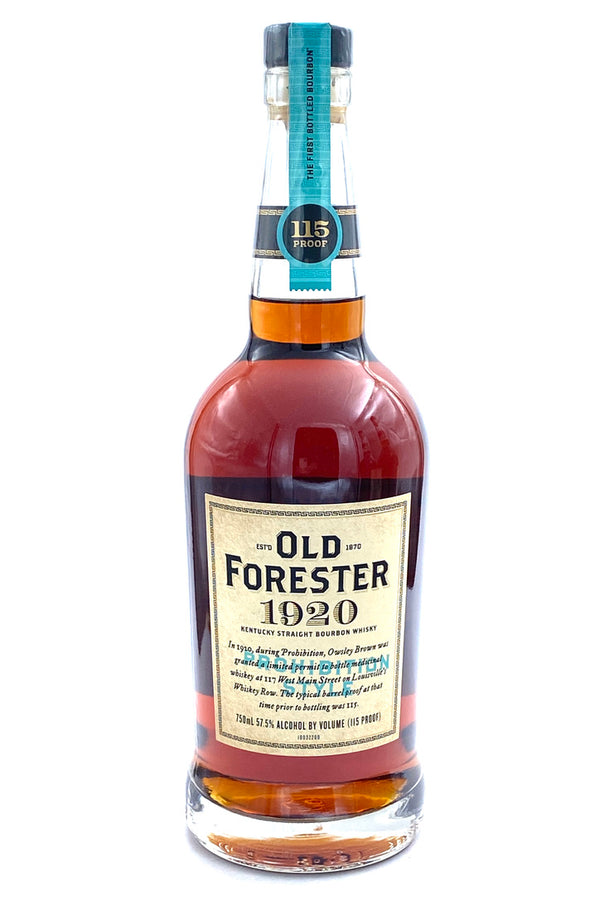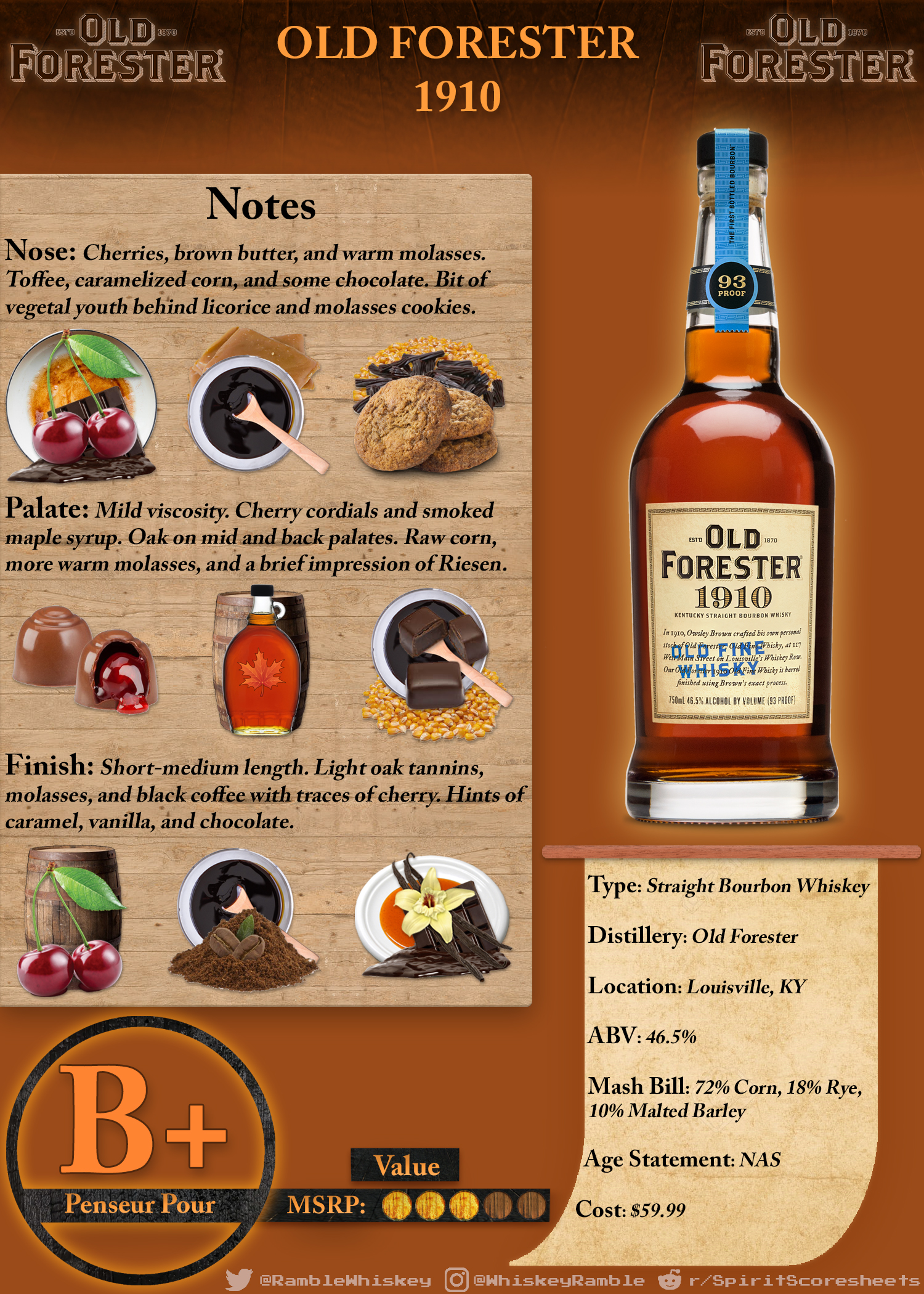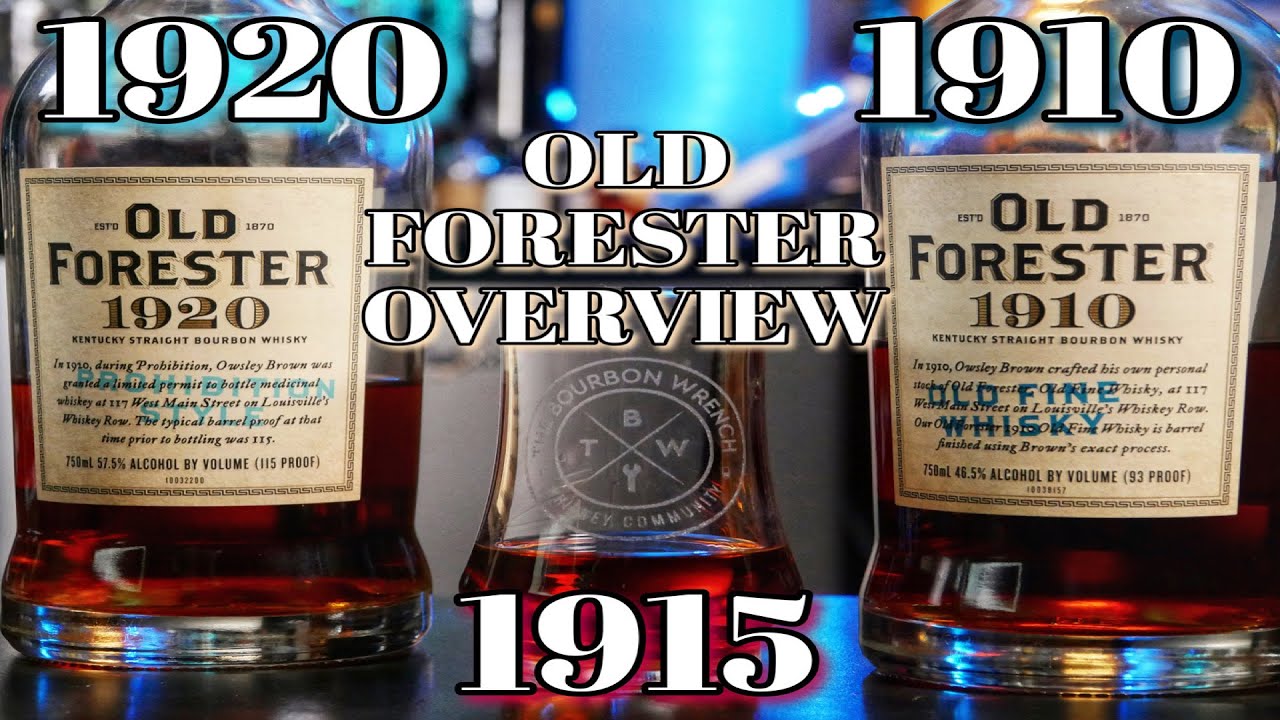
Introduction
Overview Of Old Forester’s Whiskey Row Series
Old Forester is a well-known name in the world of premium bourbons. With 150 years of distilling expertise, they have established themselves as a brand known for their rich and flavorful whiskey. One of their prominent series is the Whiskey Row series, which showcases their commitment to quality and tradition.
Significance Of Comparing Old Forester 1910 And 1920
In this blog section, we will focus on comparing two popular releases from Old Forester’s Whiskey Row series – Old Forester 1910 and Old Forester 1920. While both bourbons share similarities in terms of mash bills, ownership, and distillery, they also have distinct tasting notes that set them apart. By comparing these two releases, we can gain a better understanding of the craftsmanship and flavor profiles that Old Forester offers.
Old Forester 1910 Vs 1920
The key differences between Old Forester 1910 and 1920 can be summarized as follows:
Proof
- Old Forester 1910 has a lower alcohol proof compared to Old Forester 1920. – Old Forester 1920 has a higher alcohol proof, making it bolder, richer, and more flavorful.
Tasting Notes
- Old Forester 1910 offers a smooth and balanced flavor profile with hints of caramel, vanilla, and oak.- Old Forester 1920, on the other hand, boasts a more robust and intense flavor profile with notes of dark chocolate, dried fruit, and spice.
Ageing
- Both Old Forester 1910 and 1920 are aged for a minimum of four years.- However, Old Forester 1920 undergoes a unique aging process known as “The Whiskey Row Series” which involves a double-barrel maturation technique, resulting in a more complex and seasoned flavor profile.
Availability
- Old Forester 1910 and 1920 are both widely available in select liquor stores and online retailers.- However, due to their popularity, Old Forester 1920 might be slightly harder to find than Old Forester 1910.
Conclusion
In conclusion, comparing Old Forester 1910 and 1920 allows us to understand the nuances and distinct characteristics of these two releases. While both bourbons emanate Old Forester’s commitment to quality, they offer unique flavor profiles that cater to different palates. Whether you prefer a smoother and balanced option or a bolder and intense experience, Old Forester has something to offer for bourbon enthusiasts.
Old Forester 1910
Mash Bill, Distillery, And Ownership Details
Old Forester 1910 is part of the Whiskey Row series, showcasing the brand’s commitment to quality and tradition. It is crafted at the Old Forester Distillery in Louisville, Kentucky, which has been producing premium bourbons for over 150 years. The mash bill for Old Forester 1910 consists of 72% corn, 18% rye, and 10% malted barley. It is owned by the Brown-Forman Corporation, a family-owned company with a rich heritage in the whiskey industry.
Tasting Notes And Flavor Profile Of Old Forester 1910
Old Forester 1910 offers a smooth and balanced flavor profile that appeals to a wide range of bourbon enthusiasts. It has a deep amber color and a nose filled with notes of caramel, vanilla, and oak. On the palate, it delivers a rich sweetness reminiscent of dessert-like flavors, with hints of caramelized sugar, ripe fruits, and toasted oak. The finish is long and satisfying, with a touch of spice that lingers on the tongue.
Old Forester 1910 is known for its approachable and well-rounded flavor profile. It is a bourbon that can be enjoyed neat, on the rocks, or as a key ingredient in classic cocktails like the Old Fashioned or the Whiskey Sour. Its smoothness and balance make it an excellent choice for both experienced bourbon drinkers and newcomers to the world of whiskey.
The availability of Old Forester 1910 is widespread, with the bourbon being readily found in select liquor stores and online retailers. Its popularity and consistent quality have made it a staple in many bourbon enthusiasts’ collections.
In the next section, we will explore the key features and characteristics of Old Forester 1920, another release from the Whiskey Row series, and compare it to Old Forester 1910.
Old Forester 1920
Mash Bill, Distillery, And Ownership Details
Old Forester 1920 is another release from the Whiskey Row series by Old Forester. Crafted at the Old Forester Distillery in Louisville, Kentucky, it upholds the brand’s longstanding tradition of producing exceptional bourbons. Similar to Old Forester 1910, the mash bill for Old Forester 1920 consists of 72% corn, 18% rye, and 10% malted barley. It is also owned by the Brown-Forman Corporation, a renowned family-owned company with a deep-rooted history in the whiskey industry.
Tasting Notes And Flavor Profile Of Old Forester 1920
Old Forester 1920 distinguishes itself with a higher alcohol proof, resulting in a bolder, richer, and more flavorful experience compared to Old Forester 1910. This bourbon presents a deep mahogany color, and on the nose, it reveals enticing aromas of dark chocolate, dried fruits, and a subtle hint of oak. The flavor profile is robust and complex, with pronounced notes of caramel, roasted nuts, dark cherry, and spices such as cinnamon and clove. The higher proof amplifies the intensity of the flavors, providing a truly immersive bourbon experience.
The finish of Old Forester 1920 is long-lasting and notable, with a lingering warmth and spiciness that leaves a memorable impression. The boldness of this bourbon makes it an ideal choice for those seeking a robust and full-bodied whiskey that can stand up to bold flavors in cocktails or be enjoyed neat or on the rocks by aficionados who appreciate its complexity and depth.
In terms of availability, Old Forester 1920 can be found in select liquor stores and online retailers, allowing enthusiasts easy access to this exceptional expression from the Old Forester distillery. Whether you are a seasoned bourbon connoisseur exploring new depths of flavor or a whiskey enthusiast looking to expand your collection, Old Forester 1920 offers a distinct and worthwhile experience. Its exceptional craftsmanship and rich profile make it a valuable addition to any bourbon journey.

Comparing Old Forester 1910 And 1920
Differences In Alcohol Proof And Its Impact On Flavor
Old Forester 1920 stands out from Old Forester 1910 with its higher alcohol proof, resulting in a bolder, richer, and more flavorful experience. The higher proof amplifies the intensity of the flavors, providing a truly immersive bourbon experience. On the other hand, Old Forester 1910 has a slightly lower alcohol proof, which may result in a smoother and more mellow taste.
Similarities And Differences In Mash Bills And Distillery Heritage
Both Old Forester 1910 and 1920 share similarities in terms of their mash bills. They consist of 72% corn, 18% rye, and 10% malted barley, which contribute to the distinct flavor profiles of these bourbons. Additionally, both bourbons are crafted at the Old Forester Distillery in Louisville, Kentucky, upholding the brand’s longstanding tradition of producing exceptional bourbons.
However, there are differences in ownership between the two bourbons. Old Forester 1920 is owned by the Brown-Forman Corporation, a renowned family-owned company with a deep-rooted history in the whiskey industry. On the other hand, the ownership of Old Forester 1910 may differ, potentially offering enthusiasts a unique perspective on bourbon heritage.
In terms of tasting notes, Old Forester 1920 presents enticing aromas of dark chocolate, dried fruits, and a subtle hint of oak. Its flavor profile is defined by pronounced notes of caramel, roasted nuts, dark cherry, and spices such as cinnamon and clove. The finish is long-lasting, leaving a warm and spicy sensation on the palate.
On the other hand, Old Forester 1910 is known for its smoothness and balanced character. It offers a slightly mellow flavor profile, with hints of caramel, vanilla, and oak. The finish is pleasantly lingering, with a touch of sweetness.
While both Old Forester 1910 and 1920 have their own unique characteristics, they both exemplify the exceptional craftsmanship and rich profile that Old Forester is known for. Whether one prefers a bolder, more flavorful experience or a smoother, more mellow taste, these bourbons provide an opportunity for bourbon enthusiasts to explore and appreciate the depth and complexity of Old Forester’s offerings.
Old Forester 1910 Vs 1920: A Taste Test
Personal Experiences And Preferences Of Old Forester Enthusiasts
Old Forester 1910 and 1920 have garnered a loyal following of bourbon enthusiasts who appreciate the distinct qualities of each expression. Some individuals prefer the dessert-like sweetness and smoothness of Old Forester 1910, finding it to be an enjoyable and easy-drinking bourbon. Others gravitate towards the bold and flavorful experience offered by Old Forester 1920, relishing its higher proof and intense tasting notes. Personal preferences play a significant role in the choice between these two Old Forester releases, allowing individuals to explore their own preferences and seek out the bourbon that aligns with their taste preferences.
Analysis Of Customer Reviews And Expert Opinions
When analyzing customer reviews and expert opinions, the differences between Old Forester 1910 and 1920 become even more apparent. Many reviewers note that Old Forester 1920 stands out with its higher alcohol proof, resulting in a more intense and robust flavor profile. They describe the bourbon as bold, rich, and full-bodied, with pronounced notes of caramel, spices, and dark fruits. On the other hand, Old Forester 1910 is often praised for its smoothness and balanced character. Reviewers mention its mellow flavor profile, highlighting notes of caramel, vanilla, and oak. The lower alcohol proof of Old Forester 1910 is seen as a contributing factor to its approachable and gentle taste.
Overall, customer reviews and expert opinions reflect the unique qualities and distinctions between Old Forester 1910 and 1920. While both bourbons are crafted with the same mash bill and produced at the esteemed Old Forester Distillery, their divergent characteristics offer bourbon enthusiasts the chance to explore the spectrum of flavors and select the expression that aligns with their preferences.
In conclusion, Old Forester 1910 and 1920 are two exceptional bourbons that showcase the craftsmanship, heritage, and dedication to quality that Old Forester is renowned for. Whether one favors the bold and intense flavor experience of Old Forester 1920 or the smooth and balanced character of Old Forester 1910, these releases provide a delightful journey into the world of bourbon. Each expression offers a unique perspective on Old Forester’s rich history and the artistry of bourbon-making, allowing enthusiasts to savor and appreciate the nuanced flavors and complexities that make Old Forester bourbons truly exceptional.
Pairing Old Forester Bourbon With Food
General Guidelines For Pairing Bourbon With Food
When it comes to pairing bourbon with food, there are a few general guidelines to keep in mind. The rich and complex flavors of bourbon make it a versatile spirit that can complement a variety of dishes. Here are some tips for creating delicious bourbon and food pairings:
- Consider the flavors: Take note of the flavor profile of the bourbon you are working with. Is it sweet and fruity, or bold and spicy? Matching the flavors in the bourbon with complementary flavors in the food can create a harmonious pairing.
- Contrast or complement: You can choose to either contrast the flavors of the bourbon with the food or complement them. For example, a sweet and spicy bourbon could be paired with savory or smoky dishes for a contrasting flavor experience. On the other hand, a bourbon with hints of caramel and vanilla could be paired with desserts for a complementary pairing.
- Balance the intensity: It is important to consider the intensity of both the bourbon and the food when creating pairings. If one element is overpowering, it can detract from the overall experience. Finding a balance between the flavors and intensities will create a more enjoyable pairing.
Specific Food Pairing Recommendations For Old Forester 1910 And 1920
Now let’s delve into specific food pairing recommendations for Old Forester 1910 and 1920.
- Old Forester 1910: This bourbon is known for its dessert-like sweetness and smooth character. It pairs well with a range of dishes, including:
- Grilled pork chops with a caramelized glaze: The sweetness of the bourbon complements the caramelization on the pork chops, creating a delightful harmony of flavors.
- Vanilla bean crème brûlée: The creamy and sweet flavors of the crème brûlée match perfectly with the smoothness of Old Forester 1910.
- Dark chocolate truffles: The rich and decadent flavors of dark chocolate are enhanced by the mellow notes of caramel and oak in the bourbon.
- Old Forester 1920: With its higher proof and intense tasting notes, Old Forester 1920 can stand up to bold and flavorful dishes. Consider these pairings:
- Spicy barbecued ribs: The bold and robust flavors of the bourbon complement the smoky and spicy flavors of the ribs, creating a memorable pairing.
- Blue cheese burger: The richness and intensity of the blue cheese are balanced by the punchiness of Old Forester 1920, resulting in a harmonious combination of flavors.
- Chocolate lava cake with a hint of cayenne pepper: The spiciness of the cayenne pepper pairs well with the bold flavors of the bourbon, while the chocolate adds a touch of sweetness.
Experimenting with different pairings is part of the fun of enjoying bourbon. The distinct characteristics of Old Forester 1910 and 1920 offer bourbon enthusiasts the opportunity to explore a range of flavors and create memorable dining experiences. Whether you prefer the smooth and balanced character of Old Forester 1910 or the bold and intense flavor experience of Old Forester 1920, there is a perfect dish waiting to be paired with your chosen bourbon.

The Legacy Of Old Forester Bourbon
Historical Significance And Legacy Of The Old Forester Brand
The Old Forester brand of bourbon has a rich history and a lasting legacy in the world of whiskey. It was founded in 1870 by George Garvin Brown, making it the first bourbon to be exclusively sold in sealed glass bottles. This innovation ensured the quality and consistency of the bourbon, setting a standard for the industry.
Old Forester’s commitment to producing high-quality bourbon has continued throughout the years. The brand has survived Prohibition and economic challenges, firmly establishing itself as a pillar of the bourbon industry.
Impact Of Old Forester 1910 And 1920 On The Bourbon Industry
Old Forester 1910 and 1920 have made a significant impact on the bourbon industry. These two releases showcase the versatility and craftsmanship that Old Forester is known for.
Old Forester 1910, also known as “Old Fine Whisky”, is a unique expression that replicates the flavor profile of bourbon during the prohibition era. This release pays homage to the brand’s history and showcases its ability to produce bourbons that capture the essence of a specific time period.
Old Forester 1920, also known as “The Prohibition Style”, pushes the boundaries of flavor with its higher alcohol proof. This release appeals to bourbon enthusiasts who enjoy bold, rich, and intense flavors. It demonstrates Old Forester’s ability to innovate and cater to the evolving taste preferences of whiskey drinkers.
Both Old Forester 1910 and 1920 have garnered acclaim from critics and consumers alike, solidifying Old Forester’s position as a leading bourbon producer. These releases have contributed to the growth and popularity of the bourbon industry as a whole.
In conclusion, the legacy of Old Forester Bourbon is shaped by its historical significance, commitment to quality, and innovative releases like Old Forester 1910 and 1920. The brand’s impact on the bourbon industry cannot be overstated, and its influence continues to resonate with whiskey enthusiasts worldwide.
The Legacy Of Old Forester Bourbon
Historical Significance And Legacy Of The Old Forester Brand
Old Forester Bourbon has a rich history and a lasting legacy in the world of whiskey. Founded in 1870 by George Garvin Brown, it became the first bourbon to be exclusively sold in sealed glass bottles, ensuring the quality and consistency of the bourbon. This innovation set a standard for the industry, showcasing Old Forester’s commitment to producing high-quality bourbon.
Over the years, Old Forester has endured Prohibition and economic challenges, firmly establishing itself as a pillar of the bourbon industry.
Impact Of Old Forester 1910 And 1920 On The Bourbon Industry
Old Forester 1910 and 1920 have made a significant impact on the bourbon industry, highlighting the versatility and craftsmanship for which Old Forester is known.
Old Forester 1910, also known as “Old Fine Whisky,” replicates the flavor profile of bourbons during the prohibition era. This release pays homage to the brand’s history and showcases its ability to capture the essence of a specific time period.
Old Forester 1920, also known as “The Prohibition Style,” pushes the boundaries of flavor with its higher alcohol proof. This release appeals to bourbon enthusiasts who enjoy bold, rich, and intense flavors, demonstrating Old Forester’s ability to innovate and cater to evolving taste preferences.
Both releases have garnered acclaim from critics and consumers, solidifying Old Forester’s position as a leading bourbon producer and contributing to the growth and popularity of the bourbon industry as a whole.
Recap Of Key Differences And Similarities Between Old Forester 1910 And 1920
| Old Forester 1910 | Old Forester 1920 |
|---|---|
| Replicates flavor profile of bourbons during prohibition era | Bolder, richer, and more flavorful |
| Higher alcohol proof | |
| Appeals to bourbon enthusiasts who enjoy bold, intense flavors |
Final Thoughts On The Distinct Offerings From Old Forester
Old Forester 1910 and 1920, with their distinct characteristics and flavors, showcase the range and craftsmanship of the Old Forester brand. Whether one wants to experience the flavor of the prohibition era or indulge in a bold and intense bourbon, Old Forester offers something for every whiskey enthusiast. These releases have contributed to the brand’s ongoing legacy and solidified its status as a leading producer in the bourbon industry.
Old Forester 1910 vs 1920: Comparing Two Distinct Bourbon Offerings from Old Forester
Q: What is Old Forester 1910?
A: Old Forester 1910 is a unique bourbon offering from the Old Forester distillery. It is a part of their Whiskey Row Series and is inspired by the brand’s history during the Prohibition era. Old Forester 1910 is known for its distinctive flavor profile and smooth finish.
Q: What is Old Forester 1920?
A: Old Forester 1920 is another bourbon offering from Old Forester, also a part of their Whiskey Row Series. This particular expression pays homage to the brand’s survival during the dark years of Prohibition in the United States. Old Forester 1920 is highly regarded for its rich and robust flavor.
Q: How do Old Forester 1910 and 1920 differ in terms of production?
A: Old Forester 1910 and 1920 are both crafted using similar distillation and aging techniques. However, what sets them apart is the final step in the production process. Old Forester 1910 is double-barreled, meaning it undergoes an additional aging period in a second, heavily charred barrel. On the other hand, Old Forester 1920 is bottled at a higher proof, giving it a bolder and more intense flavor.
Q: What are the flavor profiles of Old Forester 1910 and 1920?
A: Old Forester 1910 boasts a balanced and sweet flavor profile with notes of caramel, vanilla, and hints of dried fruit. Its second barrel aging imparts a slightly smoky and oak-forward character. In contrast, Old Forester 1920 is known for its deep and complex flavors, offering a rich combination of dark chocolate, espresso, oak, and spices.
Q: Which bourbon should I choose, Old Forester 1910 or 1920?
A: The choice between Old Forester 1910 and 1920 ultimately depends on your personal preferences. If you enjoy a smoother, sweeter bourbon with a touch of smokiness, Old Forester 1910 might be the right choice for you. However, if you prefer a more intense and flavor-packed experience with deep, dark notes, Old Forester 1920 would be a better fit.
Q: Can you provide a quick comparison table of Old Forester 1910 and 1920?
| Old Forester 1910 | Old Forester 1920 | |
|---|---|---|
| Aging Technique | Double-Barreled | Bottled at a Higher Proof |
| Flavor Profile | Balanced, Sweet, Smoky | Rich, Complex, Dark |
| Notes | Caramel, Vanilla, Dried Fruit | Dark Chocolate, Espresso, Spices |
| Intensity | Moderate | Bold |
| Recommended For | Those who prefer smoothness | Those who crave intensity |
Please note that both Old Forester 1910 and 1920 are highly regarded and offer unique tasting experiences, so it’s worth trying both to see which one resonates with your palate the most.

New Life Juice Bar & Lounge (NLJB) is a vibrant and inviting organic, all-natural juice bar dedicated to providing a warm and friendly environment for all juice enthusiasts. From the moment you step through our doors, you’ll feel the positive and energizing vibes that make NLJB a must-visit destination. Our journey began with a vision to create a space where people could embrace a healthy lifestyle while enjoying delicious and nutritious organic juices. We are passionate about using only the freshest, locally sourced ingredients to craft our diverse menu of organic offerings. Whether you’re craving a rejuvenating green juice, a refreshing fruit smoothie, or a detoxifying cleanse, NLJB has something to tantalize every taste bud.